Business Finance
VerifiedAdded on 2023/01/05
|10
|3350
|78
AI Summary
Contribute Materials
Your contribution can guide someone’s learning journey. Share your
documents today.

Business
Finance
Finance
Secure Best Marks with AI Grader
Need help grading? Try our AI Grader for instant feedback on your assignments.
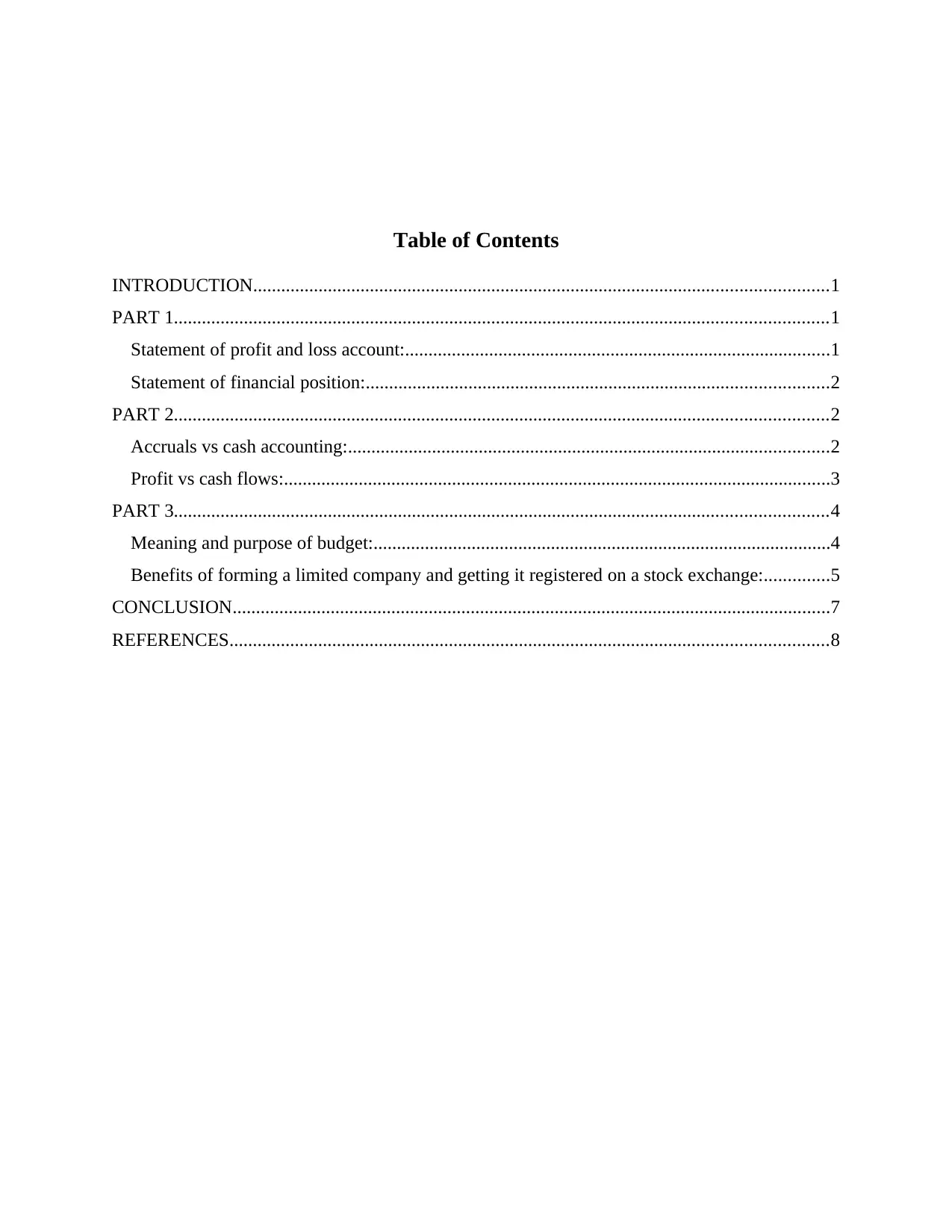
Table of Contents
INTRODUCTION...........................................................................................................................1
PART 1............................................................................................................................................1
Statement of profit and loss account:...........................................................................................1
Statement of financial position:...................................................................................................2
PART 2............................................................................................................................................2
Accruals vs cash accounting:.......................................................................................................2
Profit vs cash flows:.....................................................................................................................3
PART 3............................................................................................................................................4
Meaning and purpose of budget:..................................................................................................4
Benefits of forming a limited company and getting it registered on a stock exchange:..............5
CONCLUSION................................................................................................................................7
REFERENCES................................................................................................................................8
INTRODUCTION...........................................................................................................................1
PART 1............................................................................................................................................1
Statement of profit and loss account:...........................................................................................1
Statement of financial position:...................................................................................................2
PART 2............................................................................................................................................2
Accruals vs cash accounting:.......................................................................................................2
Profit vs cash flows:.....................................................................................................................3
PART 3............................................................................................................................................4
Meaning and purpose of budget:..................................................................................................4
Benefits of forming a limited company and getting it registered on a stock exchange:..............5
CONCLUSION................................................................................................................................7
REFERENCES................................................................................................................................8
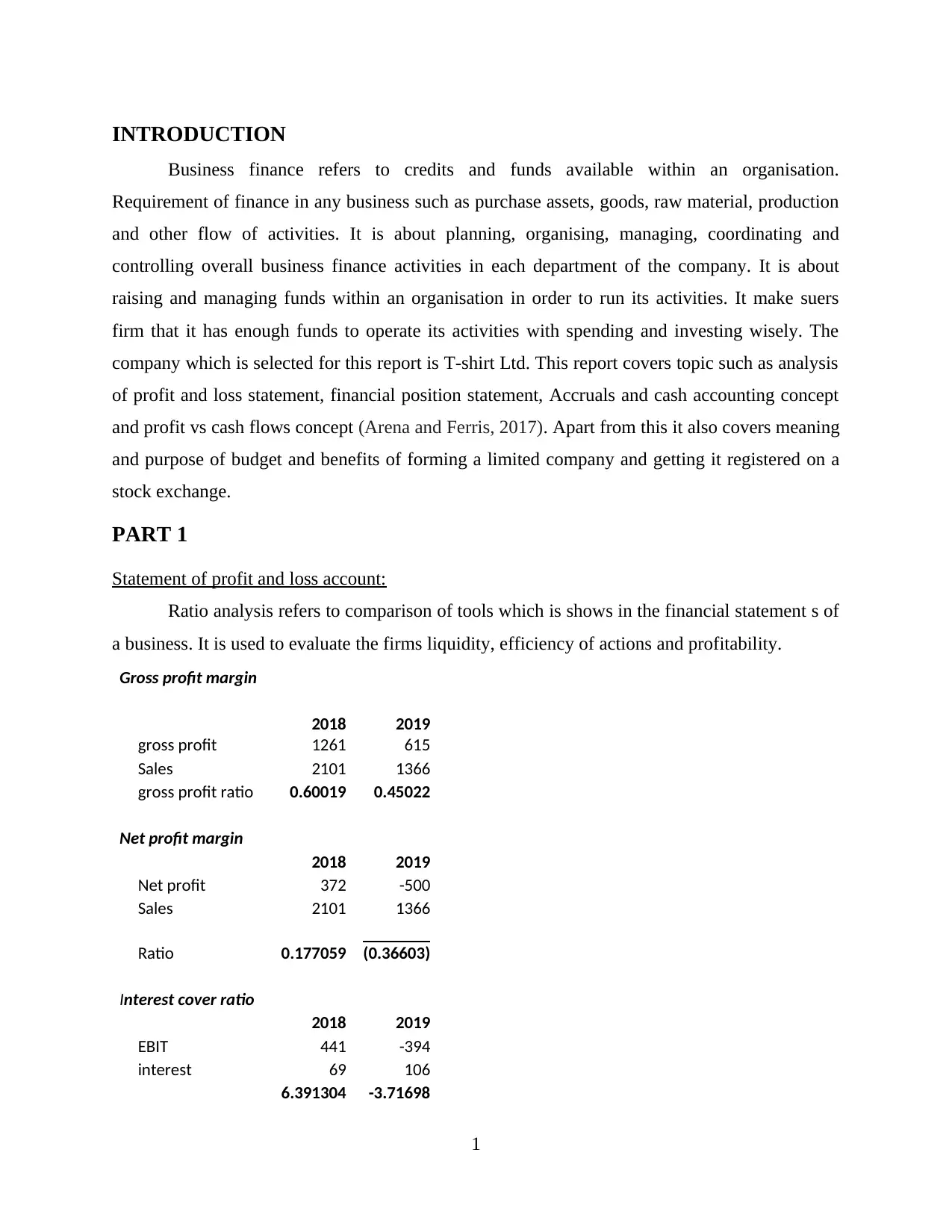
INTRODUCTION
Business finance refers to credits and funds available within an organisation.
Requirement of finance in any business such as purchase assets, goods, raw material, production
and other flow of activities. It is about planning, organising, managing, coordinating and
controlling overall business finance activities in each department of the company. It is about
raising and managing funds within an organisation in order to run its activities. It make suers
firm that it has enough funds to operate its activities with spending and investing wisely. The
company which is selected for this report is T-shirt Ltd. This report covers topic such as analysis
of profit and loss statement, financial position statement, Accruals and cash accounting concept
and profit vs cash flows concept (Arena and Ferris, 2017). Apart from this it also covers meaning
and purpose of budget and benefits of forming a limited company and getting it registered on a
stock exchange.
PART 1
Statement of profit and loss account:
Ratio analysis refers to comparison of tools which is shows in the financial statement s of
a business. It is used to evaluate the firms liquidity, efficiency of actions and profitability.
Gross profit margin
2018 2019
gross profit 1261 615
Sales 2101 1366
gross profit ratio 0.60019 0.45022
Net profit margin
2018 2019
Net profit 372 -500
Sales 2101 1366
Ratio 0.177059 (0.36603)
Interest cover ratio
2018 2019
EBIT 441 -394
interest 69 106
6.391304 -3.71698
1
Business finance refers to credits and funds available within an organisation.
Requirement of finance in any business such as purchase assets, goods, raw material, production
and other flow of activities. It is about planning, organising, managing, coordinating and
controlling overall business finance activities in each department of the company. It is about
raising and managing funds within an organisation in order to run its activities. It make suers
firm that it has enough funds to operate its activities with spending and investing wisely. The
company which is selected for this report is T-shirt Ltd. This report covers topic such as analysis
of profit and loss statement, financial position statement, Accruals and cash accounting concept
and profit vs cash flows concept (Arena and Ferris, 2017). Apart from this it also covers meaning
and purpose of budget and benefits of forming a limited company and getting it registered on a
stock exchange.
PART 1
Statement of profit and loss account:
Ratio analysis refers to comparison of tools which is shows in the financial statement s of
a business. It is used to evaluate the firms liquidity, efficiency of actions and profitability.
Gross profit margin
2018 2019
gross profit 1261 615
Sales 2101 1366
gross profit ratio 0.60019 0.45022
Net profit margin
2018 2019
Net profit 372 -500
Sales 2101 1366
Ratio 0.177059 (0.36603)
Interest cover ratio
2018 2019
EBIT 441 -394
interest 69 106
6.391304 -3.71698
1
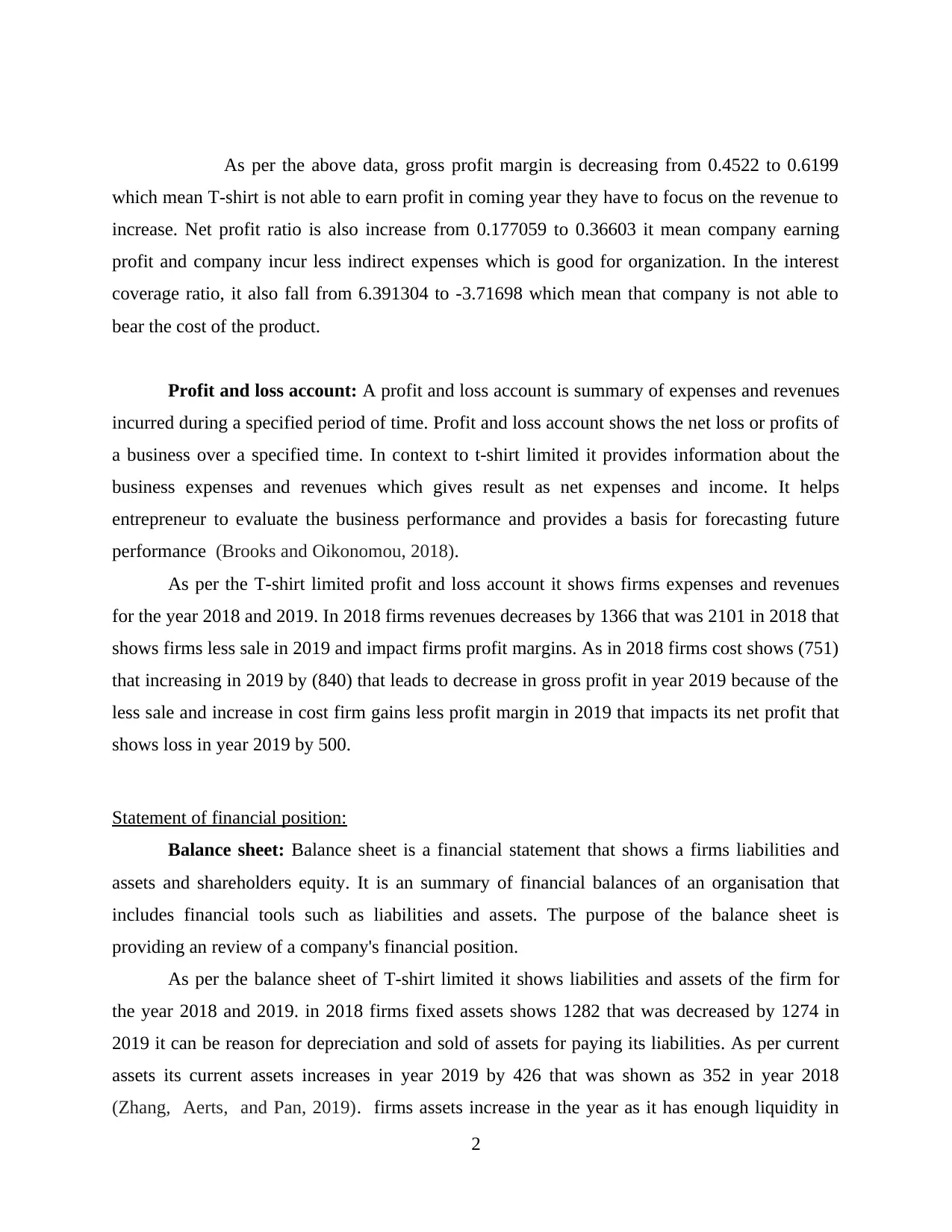
As per the above data, gross profit margin is decreasing from 0.4522 to 0.6199
which mean T-shirt is not able to earn profit in coming year they have to focus on the revenue to
increase. Net profit ratio is also increase from 0.177059 to 0.36603 it mean company earning
profit and company incur less indirect expenses which is good for organization. In the interest
coverage ratio, it also fall from 6.391304 to -3.71698 which mean that company is not able to
bear the cost of the product.
Profit and loss account: A profit and loss account is summary of expenses and revenues
incurred during a specified period of time. Profit and loss account shows the net loss or profits of
a business over a specified time. In context to t-shirt limited it provides information about the
business expenses and revenues which gives result as net expenses and income. It helps
entrepreneur to evaluate the business performance and provides a basis for forecasting future
performance (Brooks and Oikonomou, 2018).
As per the T-shirt limited profit and loss account it shows firms expenses and revenues
for the year 2018 and 2019. In 2018 firms revenues decreases by 1366 that was 2101 in 2018 that
shows firms less sale in 2019 and impact firms profit margins. As in 2018 firms cost shows (751)
that increasing in 2019 by (840) that leads to decrease in gross profit in year 2019 because of the
less sale and increase in cost firm gains less profit margin in 2019 that impacts its net profit that
shows loss in year 2019 by 500.
Statement of financial position:
Balance sheet: Balance sheet is a financial statement that shows a firms liabilities and
assets and shareholders equity. It is an summary of financial balances of an organisation that
includes financial tools such as liabilities and assets. The purpose of the balance sheet is
providing an review of a company's financial position.
As per the balance sheet of T-shirt limited it shows liabilities and assets of the firm for
the year 2018 and 2019. in 2018 firms fixed assets shows 1282 that was decreased by 1274 in
2019 it can be reason for depreciation and sold of assets for paying its liabilities. As per current
assets its current assets increases in year 2019 by 426 that was shown as 352 in year 2018
(Zhang, Aerts, and Pan, 2019). firms assets increase in the year as it has enough liquidity in
2
which mean T-shirt is not able to earn profit in coming year they have to focus on the revenue to
increase. Net profit ratio is also increase from 0.177059 to 0.36603 it mean company earning
profit and company incur less indirect expenses which is good for organization. In the interest
coverage ratio, it also fall from 6.391304 to -3.71698 which mean that company is not able to
bear the cost of the product.
Profit and loss account: A profit and loss account is summary of expenses and revenues
incurred during a specified period of time. Profit and loss account shows the net loss or profits of
a business over a specified time. In context to t-shirt limited it provides information about the
business expenses and revenues which gives result as net expenses and income. It helps
entrepreneur to evaluate the business performance and provides a basis for forecasting future
performance (Brooks and Oikonomou, 2018).
As per the T-shirt limited profit and loss account it shows firms expenses and revenues
for the year 2018 and 2019. In 2018 firms revenues decreases by 1366 that was 2101 in 2018 that
shows firms less sale in 2019 and impact firms profit margins. As in 2018 firms cost shows (751)
that increasing in 2019 by (840) that leads to decrease in gross profit in year 2019 because of the
less sale and increase in cost firm gains less profit margin in 2019 that impacts its net profit that
shows loss in year 2019 by 500.
Statement of financial position:
Balance sheet: Balance sheet is a financial statement that shows a firms liabilities and
assets and shareholders equity. It is an summary of financial balances of an organisation that
includes financial tools such as liabilities and assets. The purpose of the balance sheet is
providing an review of a company's financial position.
As per the balance sheet of T-shirt limited it shows liabilities and assets of the firm for
the year 2018 and 2019. in 2018 firms fixed assets shows 1282 that was decreased by 1274 in
2019 it can be reason for depreciation and sold of assets for paying its liabilities. As per current
assets its current assets increases in year 2019 by 426 that was shown as 352 in year 2018
(Zhang, Aerts, and Pan, 2019). firms assets increase in the year as it has enough liquidity in
2
Secure Best Marks with AI Grader
Need help grading? Try our AI Grader for instant feedback on your assignments.
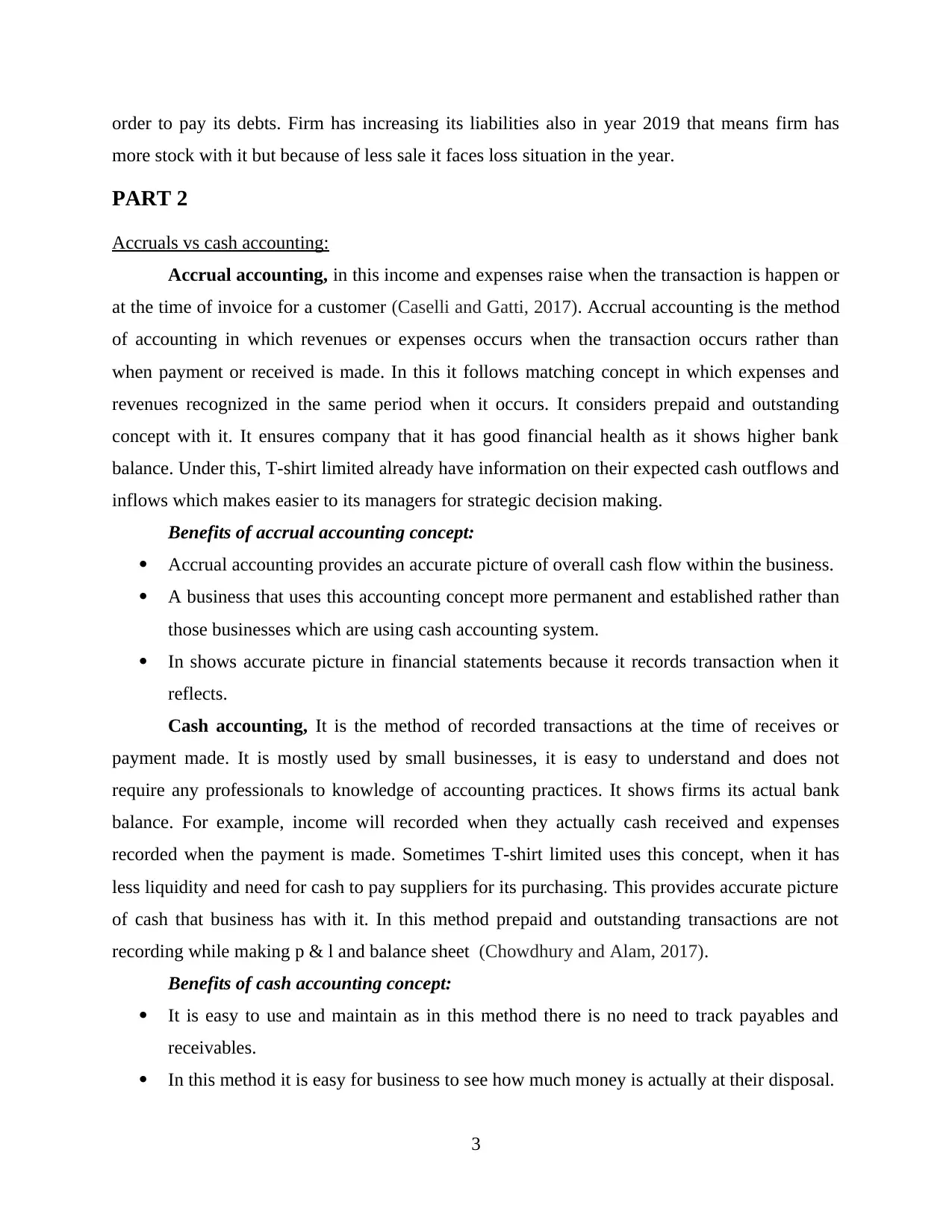
order to pay its debts. Firm has increasing its liabilities also in year 2019 that means firm has
more stock with it but because of less sale it faces loss situation in the year.
PART 2
Accruals vs cash accounting:
Accrual accounting, in this income and expenses raise when the transaction is happen or
at the time of invoice for a customer (Caselli and Gatti, 2017). Accrual accounting is the method
of accounting in which revenues or expenses occurs when the transaction occurs rather than
when payment or received is made. In this it follows matching concept in which expenses and
revenues recognized in the same period when it occurs. It considers prepaid and outstanding
concept with it. It ensures company that it has good financial health as it shows higher bank
balance. Under this, T-shirt limited already have information on their expected cash outflows and
inflows which makes easier to its managers for strategic decision making.
Benefits of accrual accounting concept:
Accrual accounting provides an accurate picture of overall cash flow within the business.
A business that uses this accounting concept more permanent and established rather than
those businesses which are using cash accounting system.
In shows accurate picture in financial statements because it records transaction when it
reflects.
Cash accounting, It is the method of recorded transactions at the time of receives or
payment made. It is mostly used by small businesses, it is easy to understand and does not
require any professionals to knowledge of accounting practices. It shows firms its actual bank
balance. For example, income will recorded when they actually cash received and expenses
recorded when the payment is made. Sometimes T-shirt limited uses this concept, when it has
less liquidity and need for cash to pay suppliers for its purchasing. This provides accurate picture
of cash that business has with it. In this method prepaid and outstanding transactions are not
recording while making p & l and balance sheet (Chowdhury and Alam, 2017).
Benefits of cash accounting concept:
It is easy to use and maintain as in this method there is no need to track payables and
receivables.
In this method it is easy for business to see how much money is actually at their disposal.
3
more stock with it but because of less sale it faces loss situation in the year.
PART 2
Accruals vs cash accounting:
Accrual accounting, in this income and expenses raise when the transaction is happen or
at the time of invoice for a customer (Caselli and Gatti, 2017). Accrual accounting is the method
of accounting in which revenues or expenses occurs when the transaction occurs rather than
when payment or received is made. In this it follows matching concept in which expenses and
revenues recognized in the same period when it occurs. It considers prepaid and outstanding
concept with it. It ensures company that it has good financial health as it shows higher bank
balance. Under this, T-shirt limited already have information on their expected cash outflows and
inflows which makes easier to its managers for strategic decision making.
Benefits of accrual accounting concept:
Accrual accounting provides an accurate picture of overall cash flow within the business.
A business that uses this accounting concept more permanent and established rather than
those businesses which are using cash accounting system.
In shows accurate picture in financial statements because it records transaction when it
reflects.
Cash accounting, It is the method of recorded transactions at the time of receives or
payment made. It is mostly used by small businesses, it is easy to understand and does not
require any professionals to knowledge of accounting practices. It shows firms its actual bank
balance. For example, income will recorded when they actually cash received and expenses
recorded when the payment is made. Sometimes T-shirt limited uses this concept, when it has
less liquidity and need for cash to pay suppliers for its purchasing. This provides accurate picture
of cash that business has with it. In this method prepaid and outstanding transactions are not
recording while making p & l and balance sheet (Chowdhury and Alam, 2017).
Benefits of cash accounting concept:
It is easy to use and maintain as in this method there is no need to track payables and
receivables.
In this method it is easy for business to see how much money is actually at their disposal.
3
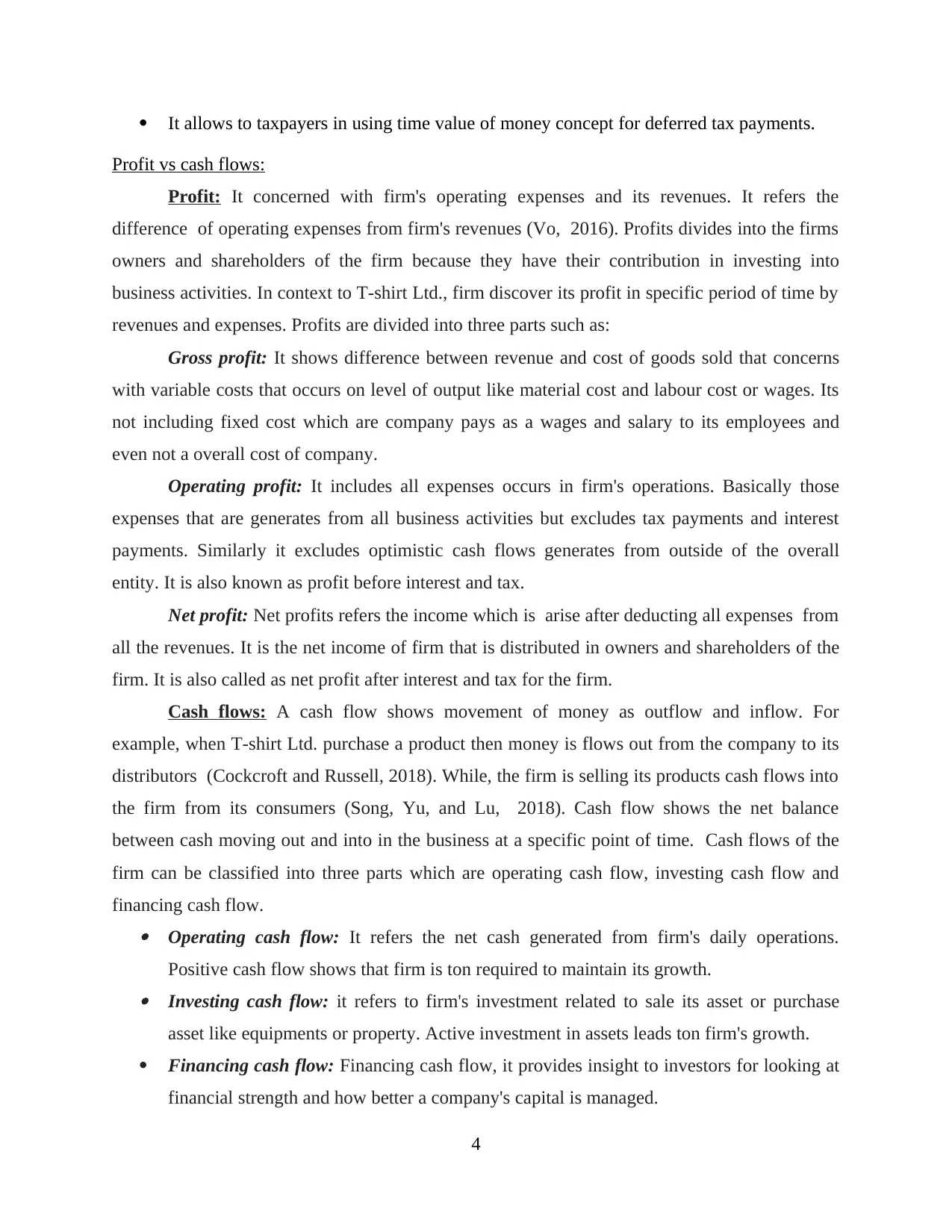
It allows to taxpayers in using time value of money concept for deferred tax payments.
Profit vs cash flows:
Profit: It concerned with firm's operating expenses and its revenues. It refers the
difference of operating expenses from firm's revenues (Vo, 2016). Profits divides into the firms
owners and shareholders of the firm because they have their contribution in investing into
business activities. In context to T-shirt Ltd., firm discover its profit in specific period of time by
revenues and expenses. Profits are divided into three parts such as:
Gross profit: It shows difference between revenue and cost of goods sold that concerns
with variable costs that occurs on level of output like material cost and labour cost or wages. Its
not including fixed cost which are company pays as a wages and salary to its employees and
even not a overall cost of company.
Operating profit: It includes all expenses occurs in firm's operations. Basically those
expenses that are generates from all business activities but excludes tax payments and interest
payments. Similarly it excludes optimistic cash flows generates from outside of the overall
entity. It is also known as profit before interest and tax.
Net profit: Net profits refers the income which is arise after deducting all expenses from
all the revenues. It is the net income of firm that is distributed in owners and shareholders of the
firm. It is also called as net profit after interest and tax for the firm.
Cash flows: A cash flow shows movement of money as outflow and inflow. For
example, when T-shirt Ltd. purchase a product then money is flows out from the company to its
distributors (Cockcroft and Russell, 2018). While, the firm is selling its products cash flows into
the firm from its consumers (Song, Yu, and Lu, 2018). Cash flow shows the net balance
between cash moving out and into in the business at a specific point of time. Cash flows of the
firm can be classified into three parts which are operating cash flow, investing cash flow and
financing cash flow. Operating cash flow: It refers the net cash generated from firm's daily operations.
Positive cash flow shows that firm is ton required to maintain its growth. Investing cash flow: it refers to firm's investment related to sale its asset or purchase
asset like equipments or property. Active investment in assets leads ton firm's growth.
Financing cash flow: Financing cash flow, it provides insight to investors for looking at
financial strength and how better a company's capital is managed.
4
Profit vs cash flows:
Profit: It concerned with firm's operating expenses and its revenues. It refers the
difference of operating expenses from firm's revenues (Vo, 2016). Profits divides into the firms
owners and shareholders of the firm because they have their contribution in investing into
business activities. In context to T-shirt Ltd., firm discover its profit in specific period of time by
revenues and expenses. Profits are divided into three parts such as:
Gross profit: It shows difference between revenue and cost of goods sold that concerns
with variable costs that occurs on level of output like material cost and labour cost or wages. Its
not including fixed cost which are company pays as a wages and salary to its employees and
even not a overall cost of company.
Operating profit: It includes all expenses occurs in firm's operations. Basically those
expenses that are generates from all business activities but excludes tax payments and interest
payments. Similarly it excludes optimistic cash flows generates from outside of the overall
entity. It is also known as profit before interest and tax.
Net profit: Net profits refers the income which is arise after deducting all expenses from
all the revenues. It is the net income of firm that is distributed in owners and shareholders of the
firm. It is also called as net profit after interest and tax for the firm.
Cash flows: A cash flow shows movement of money as outflow and inflow. For
example, when T-shirt Ltd. purchase a product then money is flows out from the company to its
distributors (Cockcroft and Russell, 2018). While, the firm is selling its products cash flows into
the firm from its consumers (Song, Yu, and Lu, 2018). Cash flow shows the net balance
between cash moving out and into in the business at a specific point of time. Cash flows of the
firm can be classified into three parts which are operating cash flow, investing cash flow and
financing cash flow. Operating cash flow: It refers the net cash generated from firm's daily operations.
Positive cash flow shows that firm is ton required to maintain its growth. Investing cash flow: it refers to firm's investment related to sale its asset or purchase
asset like equipments or property. Active investment in assets leads ton firm's growth.
Financing cash flow: Financing cash flow, it provides insight to investors for looking at
financial strength and how better a company's capital is managed.
4
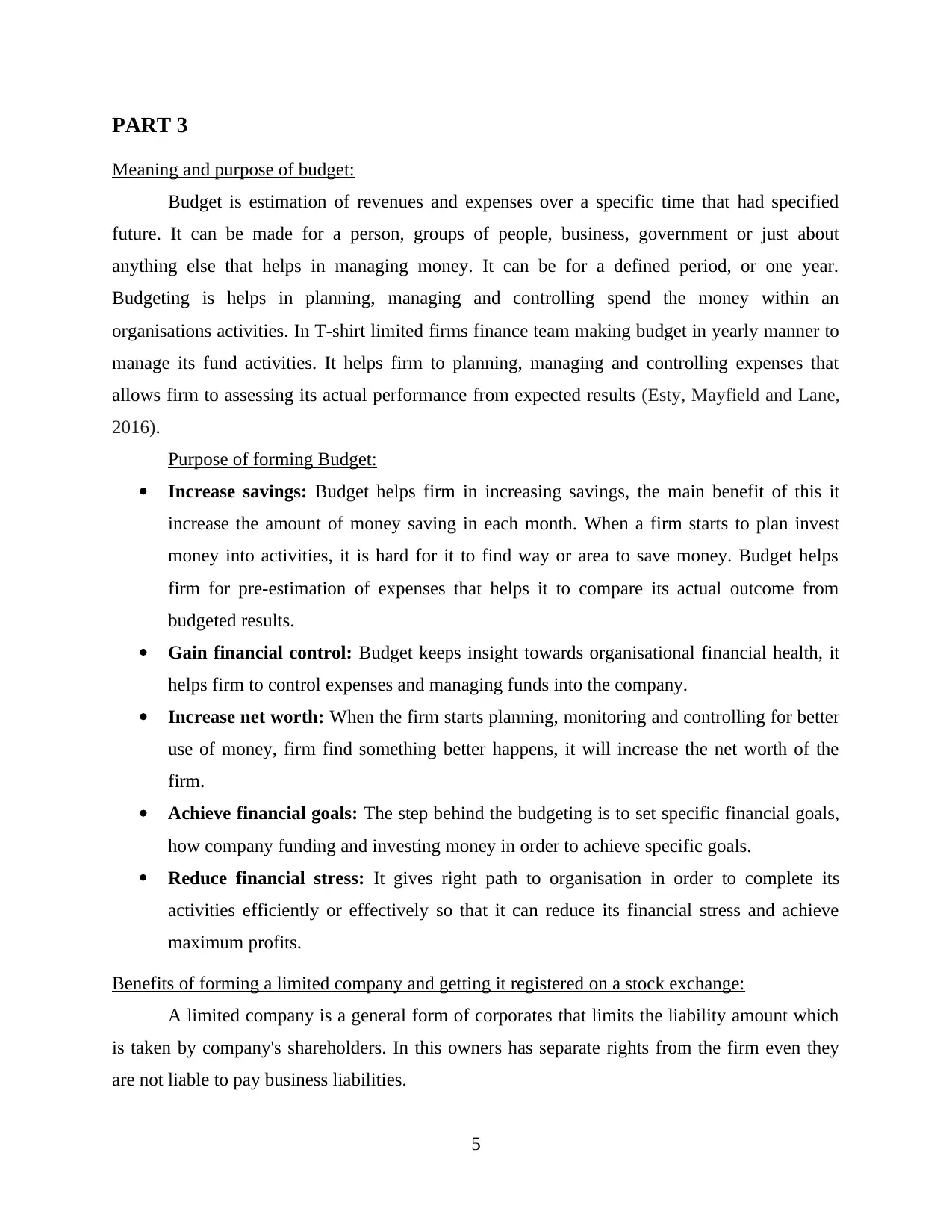
PART 3
Meaning and purpose of budget:
Budget is estimation of revenues and expenses over a specific time that had specified
future. It can be made for a person, groups of people, business, government or just about
anything else that helps in managing money. It can be for a defined period, or one year.
Budgeting is helps in planning, managing and controlling spend the money within an
organisations activities. In T-shirt limited firms finance team making budget in yearly manner to
manage its fund activities. It helps firm to planning, managing and controlling expenses that
allows firm to assessing its actual performance from expected results (Esty, Mayfield and Lane,
2016).
Purpose of forming Budget:
Increase savings: Budget helps firm in increasing savings, the main benefit of this it
increase the amount of money saving in each month. When a firm starts to plan invest
money into activities, it is hard for it to find way or area to save money. Budget helps
firm for pre-estimation of expenses that helps it to compare its actual outcome from
budgeted results.
Gain financial control: Budget keeps insight towards organisational financial health, it
helps firm to control expenses and managing funds into the company.
Increase net worth: When the firm starts planning, monitoring and controlling for better
use of money, firm find something better happens, it will increase the net worth of the
firm.
Achieve financial goals: The step behind the budgeting is to set specific financial goals,
how company funding and investing money in order to achieve specific goals.
Reduce financial stress: It gives right path to organisation in order to complete its
activities efficiently or effectively so that it can reduce its financial stress and achieve
maximum profits.
Benefits of forming a limited company and getting it registered on a stock exchange:
A limited company is a general form of corporates that limits the liability amount which
is taken by company's shareholders. In this owners has separate rights from the firm even they
are not liable to pay business liabilities.
5
Meaning and purpose of budget:
Budget is estimation of revenues and expenses over a specific time that had specified
future. It can be made for a person, groups of people, business, government or just about
anything else that helps in managing money. It can be for a defined period, or one year.
Budgeting is helps in planning, managing and controlling spend the money within an
organisations activities. In T-shirt limited firms finance team making budget in yearly manner to
manage its fund activities. It helps firm to planning, managing and controlling expenses that
allows firm to assessing its actual performance from expected results (Esty, Mayfield and Lane,
2016).
Purpose of forming Budget:
Increase savings: Budget helps firm in increasing savings, the main benefit of this it
increase the amount of money saving in each month. When a firm starts to plan invest
money into activities, it is hard for it to find way or area to save money. Budget helps
firm for pre-estimation of expenses that helps it to compare its actual outcome from
budgeted results.
Gain financial control: Budget keeps insight towards organisational financial health, it
helps firm to control expenses and managing funds into the company.
Increase net worth: When the firm starts planning, monitoring and controlling for better
use of money, firm find something better happens, it will increase the net worth of the
firm.
Achieve financial goals: The step behind the budgeting is to set specific financial goals,
how company funding and investing money in order to achieve specific goals.
Reduce financial stress: It gives right path to organisation in order to complete its
activities efficiently or effectively so that it can reduce its financial stress and achieve
maximum profits.
Benefits of forming a limited company and getting it registered on a stock exchange:
A limited company is a general form of corporates that limits the liability amount which
is taken by company's shareholders. In this owners has separate rights from the firm even they
are not liable to pay business liabilities.
5
Paraphrase This Document
Need a fresh take? Get an instant paraphrase of this document with our AI Paraphraser
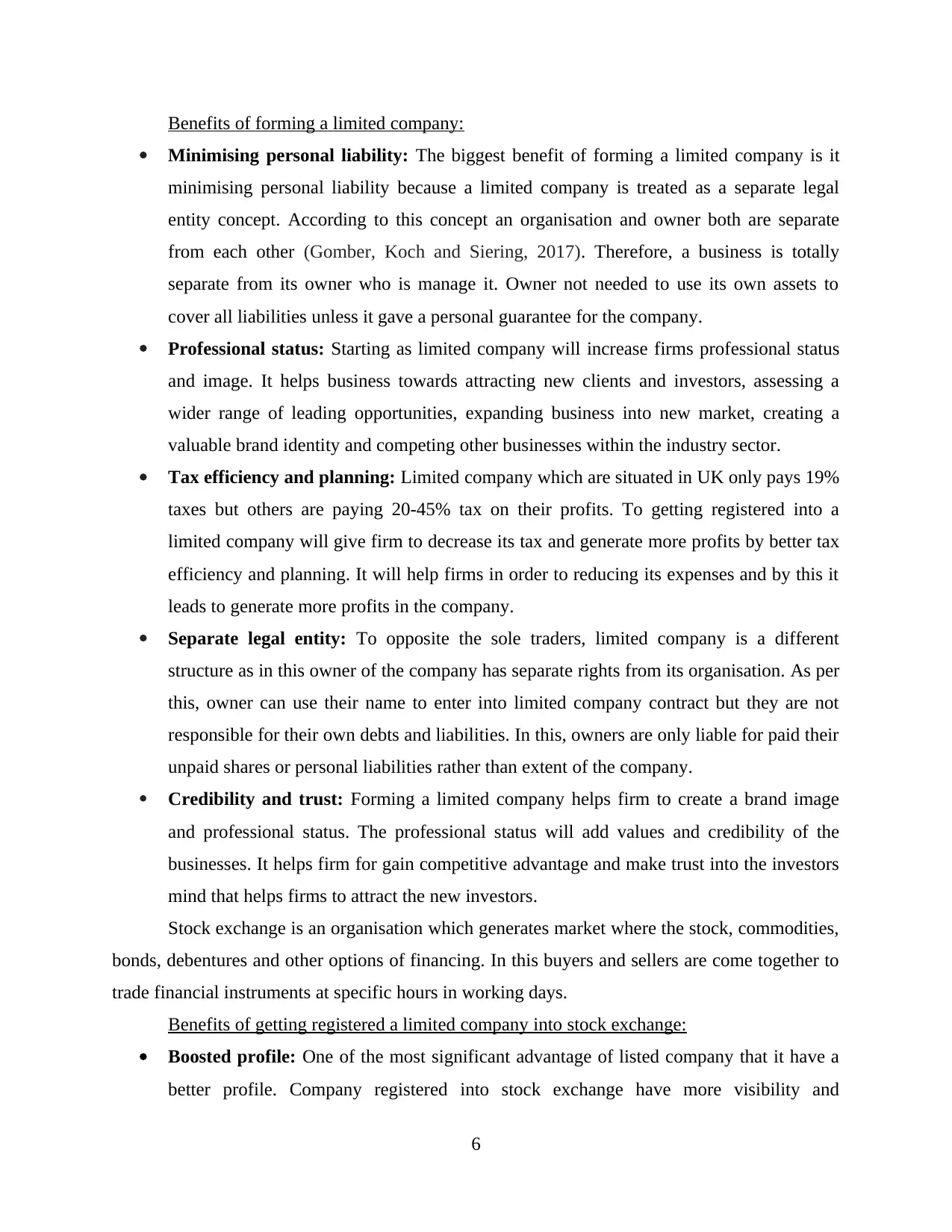
Benefits of forming a limited company:
Minimising personal liability: The biggest benefit of forming a limited company is it
minimising personal liability because a limited company is treated as a separate legal
entity concept. According to this concept an organisation and owner both are separate
from each other (Gomber, Koch and Siering, 2017). Therefore, a business is totally
separate from its owner who is manage it. Owner not needed to use its own assets to
cover all liabilities unless it gave a personal guarantee for the company.
Professional status: Starting as limited company will increase firms professional status
and image. It helps business towards attracting new clients and investors, assessing a
wider range of leading opportunities, expanding business into new market, creating a
valuable brand identity and competing other businesses within the industry sector.
Tax efficiency and planning: Limited company which are situated in UK only pays 19%
taxes but others are paying 20-45% tax on their profits. To getting registered into a
limited company will give firm to decrease its tax and generate more profits by better tax
efficiency and planning. It will help firms in order to reducing its expenses and by this it
leads to generate more profits in the company.
Separate legal entity: To opposite the sole traders, limited company is a different
structure as in this owner of the company has separate rights from its organisation. As per
this, owner can use their name to enter into limited company contract but they are not
responsible for their own debts and liabilities. In this, owners are only liable for paid their
unpaid shares or personal liabilities rather than extent of the company.
Credibility and trust: Forming a limited company helps firm to create a brand image
and professional status. The professional status will add values and credibility of the
businesses. It helps firm for gain competitive advantage and make trust into the investors
mind that helps firms to attract the new investors.
Stock exchange is an organisation which generates market where the stock, commodities,
bonds, debentures and other options of financing. In this buyers and sellers are come together to
trade financial instruments at specific hours in working days.
Benefits of getting registered a limited company into stock exchange:
Boosted profile: One of the most significant advantage of listed company that it have a
better profile. Company registered into stock exchange have more visibility and
6
Minimising personal liability: The biggest benefit of forming a limited company is it
minimising personal liability because a limited company is treated as a separate legal
entity concept. According to this concept an organisation and owner both are separate
from each other (Gomber, Koch and Siering, 2017). Therefore, a business is totally
separate from its owner who is manage it. Owner not needed to use its own assets to
cover all liabilities unless it gave a personal guarantee for the company.
Professional status: Starting as limited company will increase firms professional status
and image. It helps business towards attracting new clients and investors, assessing a
wider range of leading opportunities, expanding business into new market, creating a
valuable brand identity and competing other businesses within the industry sector.
Tax efficiency and planning: Limited company which are situated in UK only pays 19%
taxes but others are paying 20-45% tax on their profits. To getting registered into a
limited company will give firm to decrease its tax and generate more profits by better tax
efficiency and planning. It will help firms in order to reducing its expenses and by this it
leads to generate more profits in the company.
Separate legal entity: To opposite the sole traders, limited company is a different
structure as in this owner of the company has separate rights from its organisation. As per
this, owner can use their name to enter into limited company contract but they are not
responsible for their own debts and liabilities. In this, owners are only liable for paid their
unpaid shares or personal liabilities rather than extent of the company.
Credibility and trust: Forming a limited company helps firm to create a brand image
and professional status. The professional status will add values and credibility of the
businesses. It helps firm for gain competitive advantage and make trust into the investors
mind that helps firms to attract the new investors.
Stock exchange is an organisation which generates market where the stock, commodities,
bonds, debentures and other options of financing. In this buyers and sellers are come together to
trade financial instruments at specific hours in working days.
Benefits of getting registered a limited company into stock exchange:
Boosted profile: One of the most significant advantage of listed company that it have a
better profile. Company registered into stock exchange have more visibility and
6
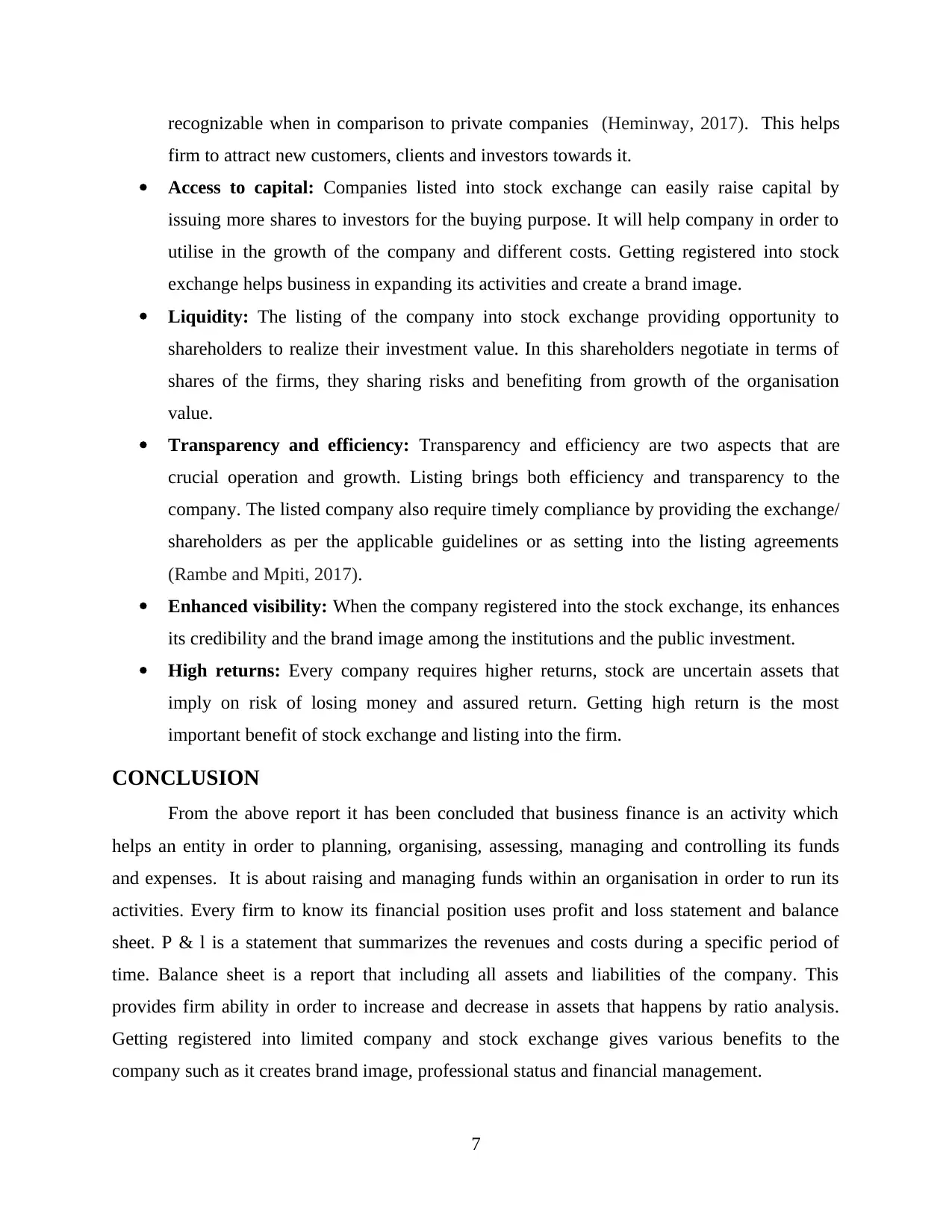
recognizable when in comparison to private companies (Heminway, 2017). This helps
firm to attract new customers, clients and investors towards it.
Access to capital: Companies listed into stock exchange can easily raise capital by
issuing more shares to investors for the buying purpose. It will help company in order to
utilise in the growth of the company and different costs. Getting registered into stock
exchange helps business in expanding its activities and create a brand image.
Liquidity: The listing of the company into stock exchange providing opportunity to
shareholders to realize their investment value. In this shareholders negotiate in terms of
shares of the firms, they sharing risks and benefiting from growth of the organisation
value.
Transparency and efficiency: Transparency and efficiency are two aspects that are
crucial operation and growth. Listing brings both efficiency and transparency to the
company. The listed company also require timely compliance by providing the exchange/
shareholders as per the applicable guidelines or as setting into the listing agreements
(Rambe and Mpiti, 2017).
Enhanced visibility: When the company registered into the stock exchange, its enhances
its credibility and the brand image among the institutions and the public investment.
High returns: Every company requires higher returns, stock are uncertain assets that
imply on risk of losing money and assured return. Getting high return is the most
important benefit of stock exchange and listing into the firm.
CONCLUSION
From the above report it has been concluded that business finance is an activity which
helps an entity in order to planning, organising, assessing, managing and controlling its funds
and expenses. It is about raising and managing funds within an organisation in order to run its
activities. Every firm to know its financial position uses profit and loss statement and balance
sheet. P & l is a statement that summarizes the revenues and costs during a specific period of
time. Balance sheet is a report that including all assets and liabilities of the company. This
provides firm ability in order to increase and decrease in assets that happens by ratio analysis.
Getting registered into limited company and stock exchange gives various benefits to the
company such as it creates brand image, professional status and financial management.
7
firm to attract new customers, clients and investors towards it.
Access to capital: Companies listed into stock exchange can easily raise capital by
issuing more shares to investors for the buying purpose. It will help company in order to
utilise in the growth of the company and different costs. Getting registered into stock
exchange helps business in expanding its activities and create a brand image.
Liquidity: The listing of the company into stock exchange providing opportunity to
shareholders to realize their investment value. In this shareholders negotiate in terms of
shares of the firms, they sharing risks and benefiting from growth of the organisation
value.
Transparency and efficiency: Transparency and efficiency are two aspects that are
crucial operation and growth. Listing brings both efficiency and transparency to the
company. The listed company also require timely compliance by providing the exchange/
shareholders as per the applicable guidelines or as setting into the listing agreements
(Rambe and Mpiti, 2017).
Enhanced visibility: When the company registered into the stock exchange, its enhances
its credibility and the brand image among the institutions and the public investment.
High returns: Every company requires higher returns, stock are uncertain assets that
imply on risk of losing money and assured return. Getting high return is the most
important benefit of stock exchange and listing into the firm.
CONCLUSION
From the above report it has been concluded that business finance is an activity which
helps an entity in order to planning, organising, assessing, managing and controlling its funds
and expenses. It is about raising and managing funds within an organisation in order to run its
activities. Every firm to know its financial position uses profit and loss statement and balance
sheet. P & l is a statement that summarizes the revenues and costs during a specific period of
time. Balance sheet is a report that including all assets and liabilities of the company. This
provides firm ability in order to increase and decrease in assets that happens by ratio analysis.
Getting registered into limited company and stock exchange gives various benefits to the
company such as it creates brand image, professional status and financial management.
7
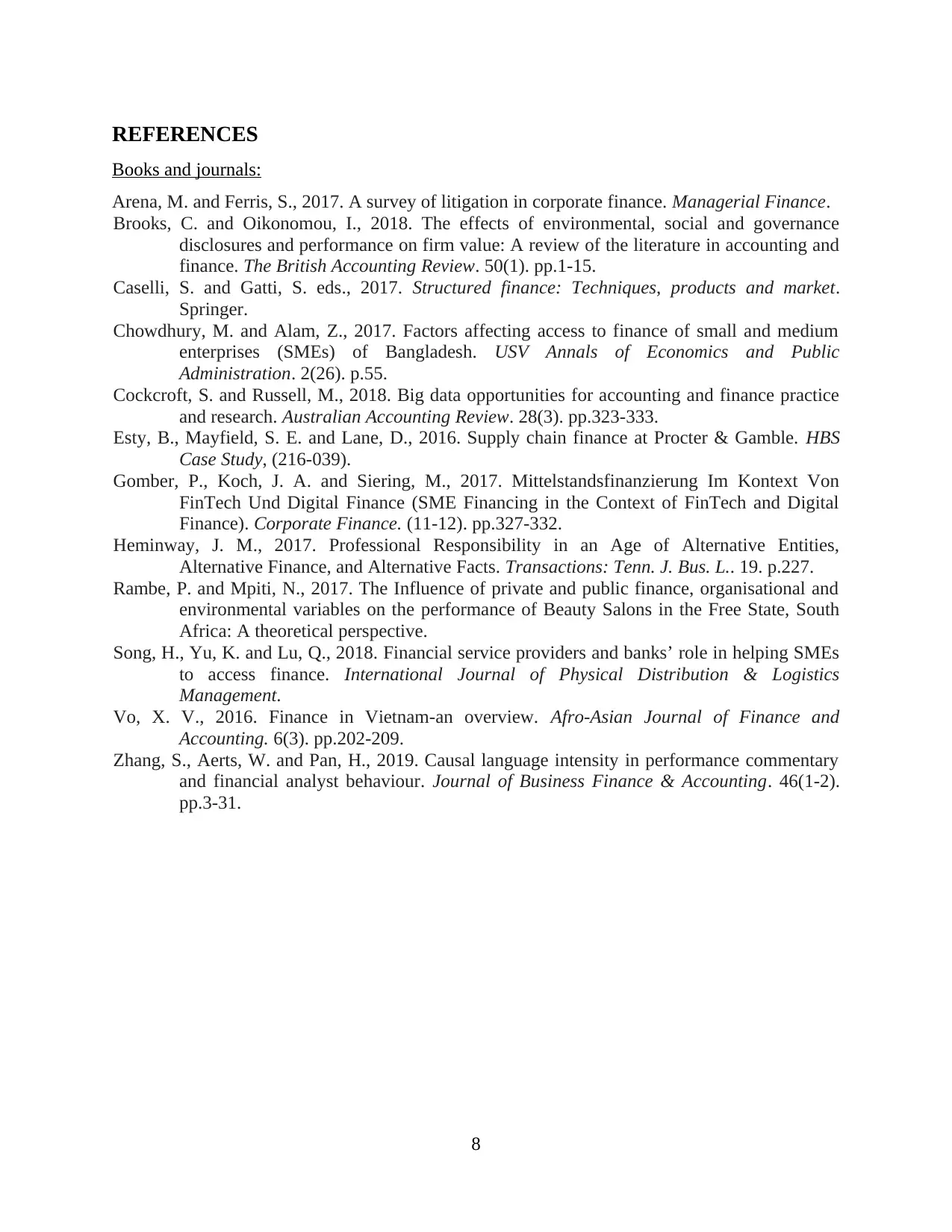
REFERENCES
Books and journals:
Arena, M. and Ferris, S., 2017. A survey of litigation in corporate finance. Managerial Finance.
Brooks, C. and Oikonomou, I., 2018. The effects of environmental, social and governance
disclosures and performance on firm value: A review of the literature in accounting and
finance. The British Accounting Review. 50(1). pp.1-15.
Caselli, S. and Gatti, S. eds., 2017. Structured finance: Techniques, products and market.
Springer.
Chowdhury, M. and Alam, Z., 2017. Factors affecting access to finance of small and medium
enterprises (SMEs) of Bangladesh. USV Annals of Economics and Public
Administration. 2(26). p.55.
Cockcroft, S. and Russell, M., 2018. Big data opportunities for accounting and finance practice
and research. Australian Accounting Review. 28(3). pp.323-333.
Esty, B., Mayfield, S. E. and Lane, D., 2016. Supply chain finance at Procter & Gamble. HBS
Case Study, (216-039).
Gomber, P., Koch, J. A. and Siering, M., 2017. Mittelstandsfinanzierung Im Kontext Von
FinTech Und Digital Finance (SME Financing in the Context of FinTech and Digital
Finance). Corporate Finance. (11-12). pp.327-332.
Heminway, J. M., 2017. Professional Responsibility in an Age of Alternative Entities,
Alternative Finance, and Alternative Facts. Transactions: Tenn. J. Bus. L.. 19. p.227.
Rambe, P. and Mpiti, N., 2017. The Influence of private and public finance, organisational and
environmental variables on the performance of Beauty Salons in the Free State, South
Africa: A theoretical perspective.
Song, H., Yu, K. and Lu, Q., 2018. Financial service providers and banks’ role in helping SMEs
to access finance. International Journal of Physical Distribution & Logistics
Management.
Vo, X. V., 2016. Finance in Vietnam-an overview. Afro-Asian Journal of Finance and
Accounting. 6(3). pp.202-209.
Zhang, S., Aerts, W. and Pan, H., 2019. Causal language intensity in performance commentary
and financial analyst behaviour. Journal of Business Finance & Accounting. 46(1-2).
pp.3-31.
8
Books and journals:
Arena, M. and Ferris, S., 2017. A survey of litigation in corporate finance. Managerial Finance.
Brooks, C. and Oikonomou, I., 2018. The effects of environmental, social and governance
disclosures and performance on firm value: A review of the literature in accounting and
finance. The British Accounting Review. 50(1). pp.1-15.
Caselli, S. and Gatti, S. eds., 2017. Structured finance: Techniques, products and market.
Springer.
Chowdhury, M. and Alam, Z., 2017. Factors affecting access to finance of small and medium
enterprises (SMEs) of Bangladesh. USV Annals of Economics and Public
Administration. 2(26). p.55.
Cockcroft, S. and Russell, M., 2018. Big data opportunities for accounting and finance practice
and research. Australian Accounting Review. 28(3). pp.323-333.
Esty, B., Mayfield, S. E. and Lane, D., 2016. Supply chain finance at Procter & Gamble. HBS
Case Study, (216-039).
Gomber, P., Koch, J. A. and Siering, M., 2017. Mittelstandsfinanzierung Im Kontext Von
FinTech Und Digital Finance (SME Financing in the Context of FinTech and Digital
Finance). Corporate Finance. (11-12). pp.327-332.
Heminway, J. M., 2017. Professional Responsibility in an Age of Alternative Entities,
Alternative Finance, and Alternative Facts. Transactions: Tenn. J. Bus. L.. 19. p.227.
Rambe, P. and Mpiti, N., 2017. The Influence of private and public finance, organisational and
environmental variables on the performance of Beauty Salons in the Free State, South
Africa: A theoretical perspective.
Song, H., Yu, K. and Lu, Q., 2018. Financial service providers and banks’ role in helping SMEs
to access finance. International Journal of Physical Distribution & Logistics
Management.
Vo, X. V., 2016. Finance in Vietnam-an overview. Afro-Asian Journal of Finance and
Accounting. 6(3). pp.202-209.
Zhang, S., Aerts, W. and Pan, H., 2019. Causal language intensity in performance commentary
and financial analyst behaviour. Journal of Business Finance & Accounting. 46(1-2).
pp.3-31.
8
1 out of 10
Related Documents
Your All-in-One AI-Powered Toolkit for Academic Success.
+13062052269
info@desklib.com
Available 24*7 on WhatsApp / Email
![[object Object]](/_next/static/media/star-bottom.7253800d.svg)
Unlock your academic potential
© 2024 | Zucol Services PVT LTD | All rights reserved.





